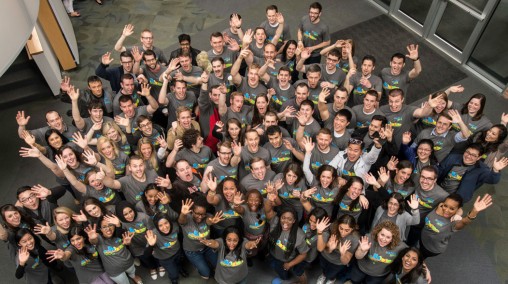 Ninety-one medical students at Wright State University Boonshoft School of Medicine learned today where they will spend the next three to five years of their lives completing residency training after receiving their medical degrees in May.
Ninety-one medical students at Wright State University Boonshoft School of Medicine learned today where they will spend the next three to five years of their lives completing residency training after receiving their medical degrees in May.
A longstanding tradition at medical schools nationwide, Match Day is a highly anticipated event. It is the day that medical students learn where they are heading as new doctors to receive advanced clinical training in a residency program.
Surrounded by friends and family in the Apollo Room of the Wright State Student Union, each student anxiously awaited for his or her envelope to be drawn from a hopper and announced by Dean Margaret M. Dunn, M.D.
In 2014, more than 40,000 applicants vied for over 29,000 residency positions at institutions across the country, and the 2015 Match is expected to be even larger, according to the National Resident Matching Program.
Depending on where they match, students will spend the next three to five years as residents receiving advanced training in a primary care field or one of dozens of medical specialties.
Wright State students matched in outstanding programs in Dayton, throughout Ohio and across the country, including at Case Western Reserve University, Duke University, Stanford University, Cambridge Health Alliance (Harvard) and Johns Hopkins Hospital.
Two in five (41 percent) Wright State graduates will remain in Ohio during residency, and one in six (16.5 percent) will remain in the Dayton area.
Close to half (44 percent) will enter a primary care field: Family Medicine: 7.7 percent; Internal Medicine: 23.1 percent; or Pediatrics: 13.2 percent.
The rest matched in 14 other specialties: Anesthesiology: 5.5 percent; Emergency Medicine: 11.0 percent; Internal Medicine/Emergency Medicine: 1.1 percent; Neurology: 1.1 percent; Obstetrics and Gynecology: 3.3 percent; Ophthalmology: 2.2 percent; Orthopaedic Surgery: 5.5 percent; Pathology: 1.1 percent; Plastic Surgery: 3.3 percent; Psychiatry: 7.7 percent; Radiology: 3.3 percent; Surgery: 7.7 percent; Urology: 2.2 percent; and Vascular Surgery: 1.1 percent.
A complete list of all matches is available at medicine.wright.edu/match.










 2026 Alumni Achievement Awards celebrate distinguished Wright State community members
2026 Alumni Achievement Awards celebrate distinguished Wright State community members  Bags, boards and bonding
Bags, boards and bonding  More than 1,000 students to graduate at Wright State’s fall commencement ceremonies
More than 1,000 students to graduate at Wright State’s fall commencement ceremonies  Wright State’s Take Flight Program helps students soar high
Wright State’s Take Flight Program helps students soar high  Wright State Police Department delivers major donation to Raider Food Pantry
Wright State Police Department delivers major donation to Raider Food Pantry 